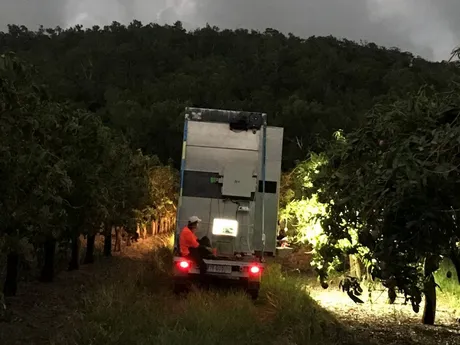CQUniversity Australia has built the world’s first mango auto-harvester, with field trials at Yeppoon of the first prototype achieving a 75 per cent efficiency in automatically identifying and picking fruit in view.
Such an overwhelmingly positive result from the first deployment of the machine is turning heads within the industry, and CQUniversity Professor Kerry Walsh is revealing details of the auto-harvester at this week’s Australian Mango Industry Association conference in Darwin.

The equipment was developed as part of a RND4Profit Commonwealth-funded research project led by an industry R&D corporation, Horticulture Innovation (Multiscale Monitoring of Tropical Fruit Trees, led by UNE).
CQUniversity researchers are now working to take their mango sensor and auto-harvest technologies to commercial-ready deployment.
Speaking on Thursday and Friday, Professor Walsh is telling the conference that the aim is now to improve the performance of the harvester to over 90 per cent efficiency of fruit in view, to increase speed and to refine its construction to reduce cost.
“The auto-harvester has the potential to solve some of the major labour force issues that currently limit the industry,” Professor Walsh said.
“The harvester is part of an integrated system which will ensure farmers know exactly how many fruit are on their trees, when they will be in perfect condition for the consumer, and when to employ the right number of people for picking and packing.
“The end goal is to save costs and improve productivity on farm, while driving consumer demand by ensuring a top-quality eating experience every time.”
Professor Walsh’s team has previously delivered to industry a near infrared spectroscopy (NIRS) measurement system to assess the eating quality of mangos and predict the ideal harvest time.
NIRS sensors and the Fruitmaps app are now adopted within the mango industry. This laid the foundation for CQUni to research in-field machine vision systems to count fruit and estimate fruit size, for fruit load estimates before harvest, allowing farmers to better plan their harvest (e.g. employing the right number of pickers at the right time).
“The next step on from that, having ‘seen’ the fruit, was to try to reach out to pick the fruit to automate the harvest,” Professor Walsh said.
"Both harvest estimates and autoharvest works best deployed in small tree-high density orchards, so this work complements the Queensland DAF work on such orchard designs.”
The prototype harvester takes approximately five seconds to harvest a fruit, from detection to placement.
Ian Groves, of Groves Grown Fruit, Yeppoon, hosted the first field trials of the prototype auto-harvester and was excited by the “game-changing” potential of the technology.
“The machinery identifying and counting fruit in the orchard turned out to be within just a few per cent of the actual number of fruit in the entire block last year,” Mr Groves said.
“That technology is also able to measure the size range of that fruit and so knowing how much fruit is in that block, knowing when it’s going to be mature and knowing the size of the fruit, means we can schedule our workforce, order the right number of cartons, the size of the inserts going into those cartons – this could be a real game changer, not only for our farm but for the entire industry.”
The auto-harvester was mounted on a trailer and towed by a ute. The next phase of research will investigate options for it to be mounted on a terrestrial drone to operate autonomously, at faster speeds and higher accuracies.
For more information:
https://www.cqu.edu.au/research
